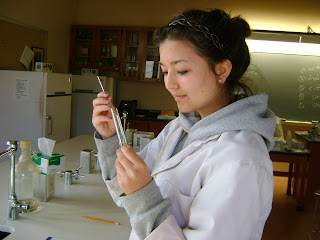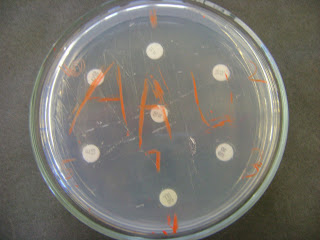To start the lab period off, we took out our streak plates made from our frozen samples out of the incubator. Our bacteria (from my throat!) did grow again after it was frozen. This proves that the freezer did preserve the bacteria and not destroy it. The frozen sample is remaining in the freezer in the back, and will preserve for a very long time (my grandchildren could even see it!)
Environmental Bacteria Growth (right half of plate)
Inoculating A Slant
In the next part of lab we performed the ELISA test. This tests for the presence of HIV by using how antigens and antibodies react to one another. In the experiment, the class used the HIV antigen. We added 15 μL (micro liters) of this antigen to each little cup in the tube. We let it sit for 5 minutes, dumped the solution down the sink and than dried out the cups with paper towels. Taking a new pipette cap, we washed the cups with wash buffer. [This procedure occurred twice]. The class then added antibody serums from humans. The first 3 cups received 50 μL of positive (to act as a control), the next 3 cups received 50 μL of negative (again as a control group), and the last four cups were each assigned an unknown. The cups were then dumped & rewashed with the wash buffer and dried. Than 50 μL of the secondary antibody was added to each serum; dumped & rewashed with buffer solution & dried. The class than added 50 μL of sheep enzyme (with a blue indicator) that bonded to the human antibodies. Since the indicator was blue, the serum turned a blue color when the sheep enzymes bonded to the human antibodies (a blue color indicating positive for HIV).
The 3 blue cups on the right indicate HIV
Since in our test only the positive control turned blue this is a direct indication that none of our unknowns had HIV!
Beef Purity Test
The last part of lab, the class got to check how pure a sample of ground beef was. Taking an agar plate, we suctioned out wells and filled them with different solutions and judged their reactions. We took a sample of raw hamburger meat that was provided for us and tested it with Bovine Albumin, Goat Anti-horse Albumin, Goat Anti-bovine Albumin, & Goat Anti-swine Albumin. If the samples do in fact react to each other than a white solid line will appear. Since the samples must sit for at least 48 hours, join us next lab to see the results!
Annie B















